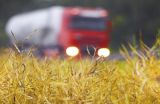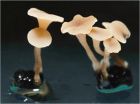(Press-News.org) To transport substances from the site of their production to their destination, the body needs a sophisticated transport and sorting system. Various receptors in and on the cells recognize certain molecules, pack them and ensure that they are transported to the right place. One of these receptors is Sortilin. It is present in the cells of the nervous system, the liver, and the immune system. Studies by Stefanie Herda and Dr. Armin Rehm (Max Delbrück Center for Molecular Medicine, MDC, Berlin-Buch and Charité–Universitätsmedizin Berlin) and the immunologist Dr. Uta Höpken (MDC) have now shown that the receptor Sortilin plays an important role in the function of the immune system (Immunity, doi: 10.1016/j.immuni.2012.07.012)*.
In the search for diseases, the T cells of the immune system go on patrol throughout the body. If they encounter a cell infected by viruses, they bind to it and secrete substances that ensure that the target cell dies. One of these substances is granzyme A, which penetrates the infected cell and induces programmed cell death. In addition, the immune cells secrete interferon-gamma, which induces the surrounding cells to have a stronger immune response.
Interferon-gamma is produced by cytotoxic T cells (formerly: T killer cells), T helper cells and natural killer cells. It enhances the activity of immune cells and induces other cells of the body to increasingly present fragments of the pathogen on their surface so that the T cells can find the affected cells more easily. To facilitate the transport of interferon-gamma from the interior of the T cell where it is produced to the cell membrane where it can be released, the cell uses its interior processing and transport system, to which the Golgi apparatus belongs.
If one were to imagine the Golgi apparatus as a post office, Sortilin's task is to wrap the interferon-gamma cargo into these packages and navigate them to their destination. Without Sortilin, however, the packages cannot be delivered and remain in the post office, that is in the Golgi apparatus. Correspondingly, in the serum, i.e. outside of the cell, too little interferon-gamma is present. Thus, lack of interferon-gamma is not caused by diminished production, but rather by reduced or abrogated transport activity, eventually preventing the interferon-gamma from reaching its destination. This in turn leads to a weakened immune defense system since the interferon can only exert its immune-stimulating effect when it is released from the immune cells.
While the transport of interferon-gamma is disturbed in the absence of Sortilin, the transport of granzyme A, which destroys diseased cells directly, is more effective. Granzyme A uses another transport pathway, which is dependent on a multi-part receptor complex. This complex includes the molecule VAMP7. Together with its binding partners, this molecule ensures that transport packages containing granzyme A as part of its cargo reach their correct address in the cell. The work of the researchers led by Dr. Rehm suggests that Sortilin has an indirect influence on VAMP7 by promoting transport routes that lead to the degradation of VAMP7. In cells lacking Sortilin the researchers were able to detect increased VAMP7. This condition allowed for a more efficient transport and therefore an increased release of granzyme A.
Accordingly, Sortilin influences two different transport pathways for key immunological effector molecules in an opposite manner. Without Sortilin, less interferon-gamma is available, instead there is an increased level of granzyme A. But the increased concentration of granzyme A cannot compensate for the interferon gamma deficiency. In the experiment, the immune system of mice in which the researchers had deactivated Sortilin was significantly weaker and the fight against viruses and bacteria was less effective. The advantage for these animals, however, was that autoimmune diseases – that is, diseases in which one's own immune system reacts against the body – were much less pronounced.
###
*The sorting receptor Sortilin exhibits a dual function in exocytic trafficking of interferon-γ and granzyme A in T cells
Stefanie Herda1, Friederike Raczkowski2, Hans-Willi Mittrücker2, Gerald Willimsky3, Kerstin Gerlach1, Anja A. Kühl4, Tilman Breiderhoff5, Thomas E. Willnow5, Bernd Dörken1,6, Uta E. Höpken7, Armin Rehm1,6
1 Max-Delbrück-Center for Molecular Medicine (MDC); Department of Hematology, Oncology and Tumorimmunology, 13125 Berlin, Germany
2 Institute for Immunology, University Medical Center, 20246 Hamburg-Eppendorf, Germany
3 Charité- Universitätsmedizin Berlin, Institute of Immunology, 12200 Berlin, Germany
4 Charité- Universitätsmedizin Berlin, Department of Pathology/Research Center Immuno Sciences, 12200 Berlin, Germany
5 Max-Delbrück-Center for Molecular Medicine (MDC); Department of Molecular Cardiovascular Research, 13125 Berlin, Germany
6 Charité- Universitätsmedizin Berlin, Department of Hematology, Oncology and Tumorimmunology, 13353 Berlin, Germany
7 Max-Delbrück-Center for Molecular Medicine (MDC); Department of Tumor- and Immunogenetics, 13125 Berlin, Germany
Contact:
Barbara Bachtler
Press Department
Max Delbrück Center for Molecular Medicine (MDC) Berlin-Buch
in the Helmholtz Association
Robert-Rössle-Straße 10; 13125 Berlin, Germany
Phone: +49 (0) 30 94 06 - 38 96; Fax: +49 (0) 30 94 06 - 38 33
e-mail: presse@mdc-berlin.de
http://www.mdc-berlin.de/
Researchers elucidate transport pathway of immune system substances
2012-10-18
ELSE PRESS RELEASES FROM THIS DATE:
Food vs. fuel: Is there surplus land for bioenergy?
2012-10-18
Braunschweig/ Leipzig. An interdisciplinary team of 11 scientists from seven European countries and the USA have discussed the concept to utilize so called surplus land for the production of feedstock for bioenergy. They identified environmental, economic and social constraints but also options for efficient use of surplus land for bioenergy. The study provides a scientific background in support of a reassessment of land available for bioenergy feedstock production. Their findings were published in the open access journal BioRisk.
Increasing demand for bioenergy feedstock ...
Italian Health Minister joins international call for secondary fracture prevention
2012-10-18
A newly released IOF report for World Osteoporosis Day, 'Capture the Fracture – A global campaign to break the fragility fracture cycle', clearly outlines the care gap which is leaving millions of fracture patients undiagnosed and without treatment for osteoporosis or assessment for falls risk.
IOF CEO Judy Stenmark stated, "An adult who has experienced a first fragility fracture – often at the wrist or vertebrae – is at double the risk of having a fracture as compared to someone who hasn't fractured. Despite this red flag indicating osteoporosis and high risk of subsequent ...
Antibiotic shows promise in treating extensively drug-resistant tuberculosis
2012-10-18
WHAT:
When tested in patients hospitalized with extensively drug-resistant tuberculosis (XDR-TB) unresponsive to previous treatment, linezolid, an antibiotic used to treat severe bacterial infections, proved largely effective when added to the patients' ongoing TB treatment regimen. Also, few patients developed resistance to the drug. These promising findings were tempered, however, by the fact that 82 percent of the patients who received linezolid experienced significant adverse events that may have been related to the drug. Findings from the study appear in the ...
A little science goes a long way
2012-10-18
PULLMAN, Wash. - A Washington State University researcher has found that engaging elementary school students in science for as little as 10 hours a year can lead to improved test scores in math and language arts.
Samantha Gizerian, a clinical assistant professor in WSU's Department of Veterinary and Comparative Anatomy, Pharmacology and Physiology, saw improved test scores among fourth-grade students in South Los Angeles after students from the Charles R. Drew University of Medicine and Science gave 10 one-hour presentations on science.
"A lot of students say things like, ...
Criminal punishment and politics: Elected judges take tougher stance prior to elections
2012-10-18
UNIVERSITY OF CALIFORNIA, BERKELEY'S HAAS SCHOOL OF BUSINESS –The last few months leading up to an election can be a critical, political game changer. One right or one wrong move can quickly change a candidate's standing at the polls. New research suggests that judges who are elected, rather than appointed, respond to this political pressure by handing down more severe criminal sentences – as much as 10 percent longer –in the last three months before an election compared with the beginning of their terms.
"We can't say if more severe sentencing is better for society or ...
Non-infected babies born to HIV mothers have reduced immunity to measles
2012-10-18
Non-infected babies born to HIV positive mothers should be vaccinated early against measles, to avoid them acquiring the virus or passing it on to others.
A study published in the November issue of Acta Paediatrica found that even if babies are born without HIV, their maternally derived protection against measles may be impaired by their mother's positive HIV status.
"The eradication of measles is high on the agendas of the World Health Organization and other international agencies and it is important to define and target any new group of susceptible infants" says ...
Some 500 scientists have created a Top 10 list of plant-damaging fungi
2012-10-18
Almost 500 international experts have worked together to develop a ranking system of the ten most important phytopathogenic fungi on a scientific and economic level. The rice blast fungus (Magnaporthe oryzae) sits at the top of the list.
A survey conducted on 495 international researchers resulted in a list contaning the most important phytopathogenic fungi. Each researcher chose three that they thought to be most significant and the most voted then formed the list.
Said list has been published in the journal Molecular Plant Pathology and each one of the species mentioned ...
Viruses act like 'self-packing suitcases'
2012-10-18
Researchers at the University of Leeds have identified a crucial stage in the lifecycle of simple viruses like polio and the common cold that could open a new front in the war on viral disease.
The team are the first to observe at a single-molecule level how the genetic material (genome) that forms the core of a single-strand RNA virus particle packs itself into its outer shell of proteins. Lead researcher Professor Peter Stockley said their results overturn accepted thinking about the process and could open a chink in the armour of a wide range of viruses.
"If we can ...
Scientists harness immune system to prevent lymphoma relapse
2012-10-18
UK scientists hope that lymphoma patients could benefit from a new drug that triggers the cancer-fighting properties of the body's own immune system, after highly promising early laboratory results.
The University of Manchester researchers, who were funded by the charity Leukaemia & Lymphoma Research, have shown that, when used in conjunction with radiotherapy, the new drug is potentially four times more likely to lead to long-term survival than radiotherapy alone.
Relapse is a common fate for many lymphoma patients and new treatments are desperately needed. The new ...
Genes and immune system shaped by childhood poverty, stress
2012-10-18
A University of British Columbia and Centre for Molecular Medicine and Therapeutics (CMMT) study has revealed that childhood poverty, stress as an adult, and demographics such as age, sex and ethnicity, all leave an imprint on a person's genes. And, that this imprint could play a role in our immune response.
The study was published last week in a special volume of the Proceedings of the National Academy of Sciences that looks at how experiences beginning before birth and in the years after can affect the course of a person's life.
Known as epigenetics, or the study ...

